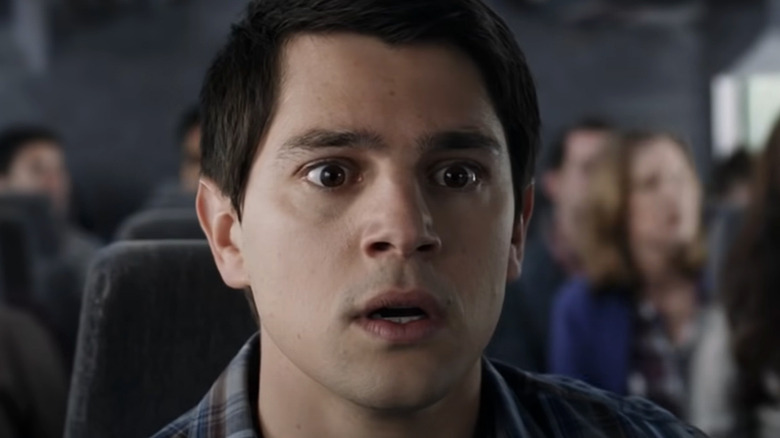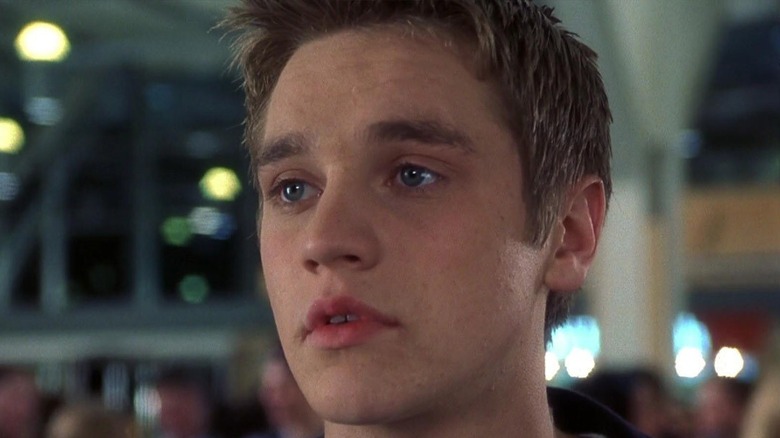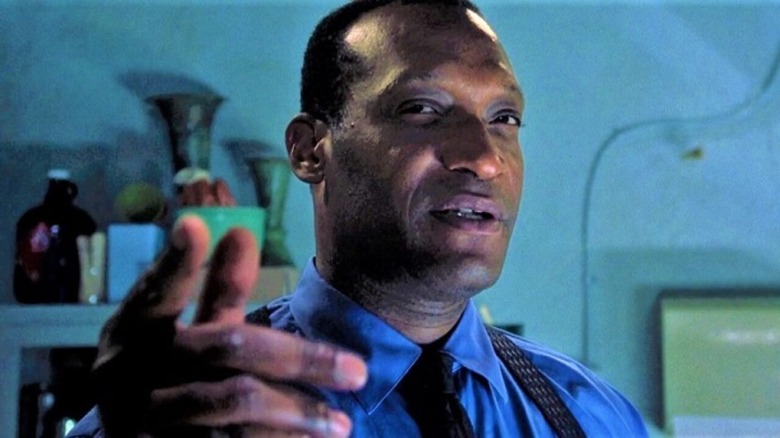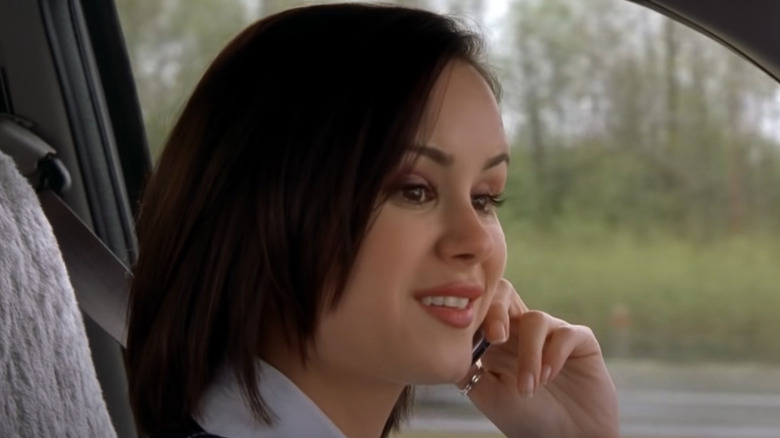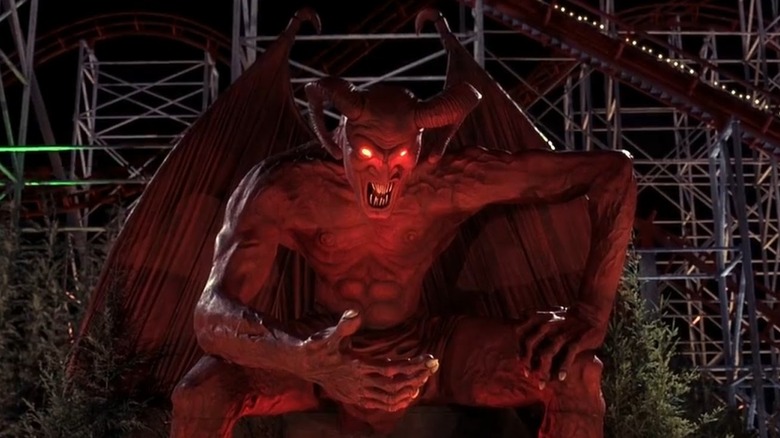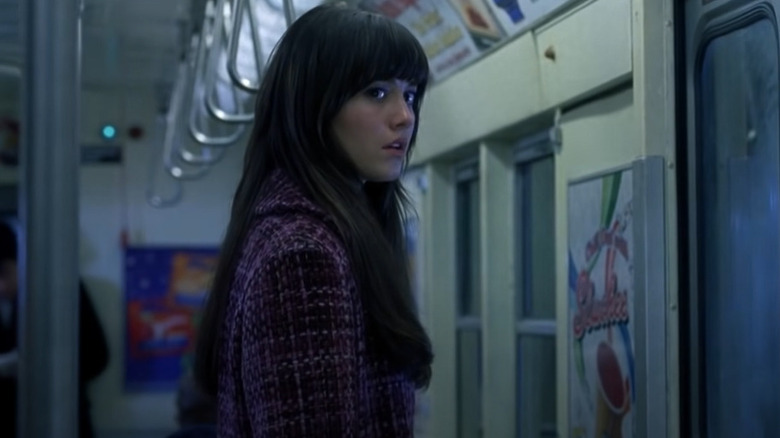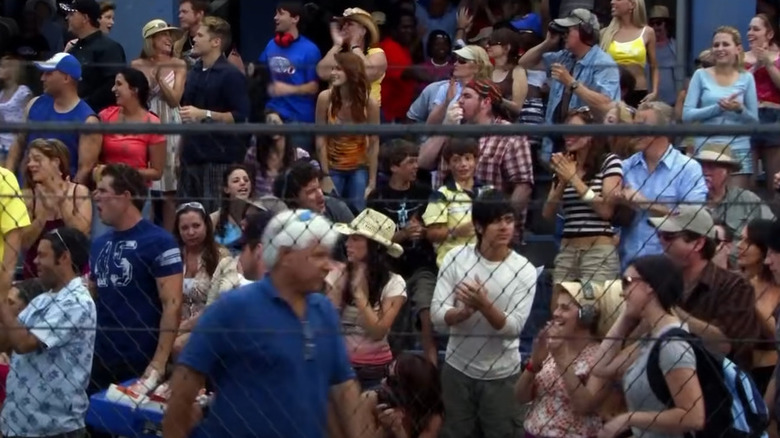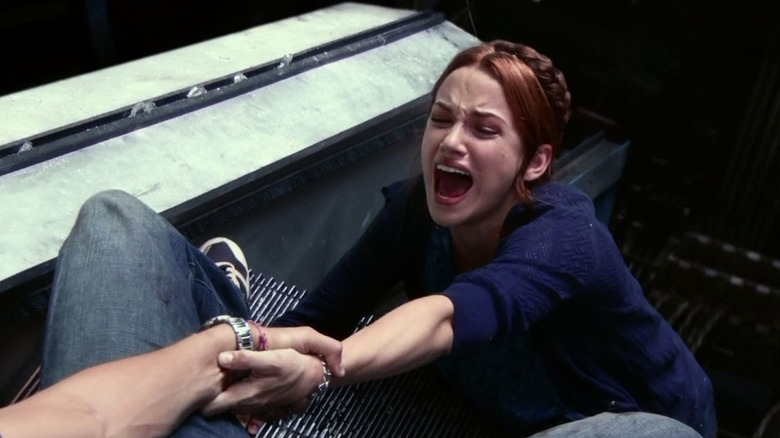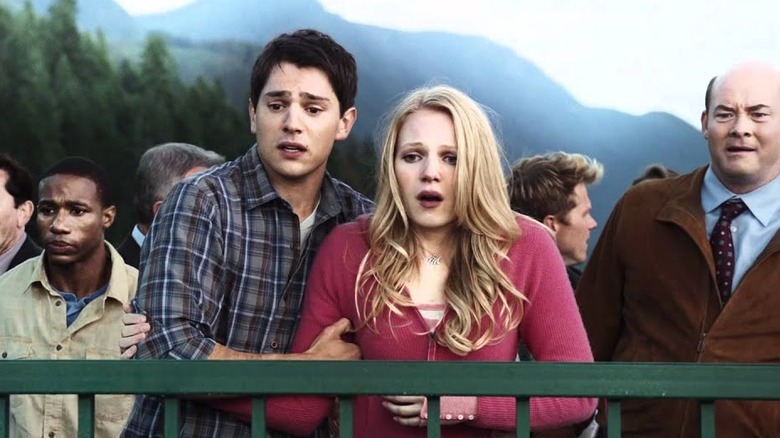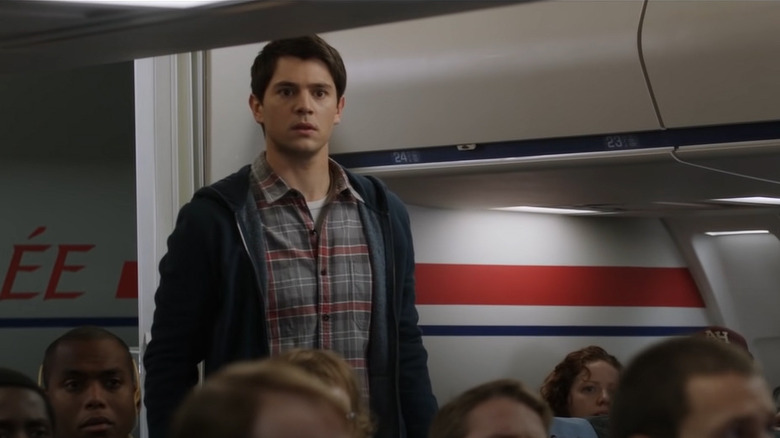The Ending Of Every Final Destination Movie Explained
The "Final Destination" film series has earned a place in the pantheon of classic horror franchises thanks to its unique take on an old formula. Rather than a psychotic slasher cutting up teenage meatbags, the serial killer in these films is Death itself. Every movie in the series, from the 2000 original to 2011's "Final Destination 5," begins with a horrible accident that kills many people in very R-rated fashion. This is later revealed to be a premonition glimpsed by the lead character. After a suitable freak-out, the protagonist and several of their friends/co-workers/random strangers escape their fate ... or so they think.
Over the course of each film, the survivors of these accidents are picked off, one by one. Furthermore, with each successive movie, the kills become increasingly elaborate and gory. Here, we find the appeal of the "Final Destination" movies: It isn't in the characters or their doomed efforts to elude Death, but in the deaths themselves. Across five films (with a sixth on the way, according to Deadline), the "Final Destination" franchise offers a plethora of these painful demises, often occurring in the final scene. It also builds up a degree of lore, and even some recurring themes. We're here to take a look at the series' larger story by examining and explaining the ending of every "Final Destination" film, in all their grisly glory.
The airplane of death
The original "Final Destination," released in 2000, follows the survivors of Flight 180. Protagonist Alex Browning (Devon Sawa) boards an airplane with his friends for a high school trip to France. But when he has a vision of the plane exploding, he appropriately freaks out and starts a fight that leads to him and several of his classmates getting ejected from the flight. Others, including Clear Rivers (Ali Larter), leave of their own volition, due to Alex's claim that the plane will explode.
When Alex is proven right, the survivors are initially grateful for his premonition. However, when they start to die in freak accidents, they become paranoid and distrustful of one another. This fear is deepened by the appearance of William Bludworth (Tony Todd), a mysterious coroner who is suspiciously knowledgeable about the rules of death. One of the very few recurring characters in the series, Bludworth can be interpreted as an avatar of Death, or possibly a survivor of Death's machinations. His overall role and knowledge of Death's methods are two of the series' recurring mysteries.
Death picks off the survivors
Over the course of the 2000 film, characters die grisly deaths — though they're not as gory as ones featured in sequels. Eventually, only three remain: Alex Browning, Clear Rivers, and Carter Horton (Kerr Smith). In the original ending, as reported by Consequence, Alex dies to protect a pregnant Clear, with whom he has a much more overtly romantic relationship. Thus, both Clear and Carter survive. However, after poor test screenings took place, this ending was altered. In the final theatrical release, Clear isn't pregnant and doesn't have an explicitly romantic relationship with Alex. The final scene, set in Paris, sees Alex survive while Carter gets splattered by a giant falling billboard.
This rejiggered ending establishes a rule followed by the successive films: There's no real way to cheat death. The end can be postponed for a period of time, but it cannot be fully stopped. This lesson is learned the hard way by Clear and Alex, the only two survivors of "Final Destination," in the sequel, 2003's "Final Destination 2."
A deadly highway pile-up
While the original film is certainly rated R, "Final Destination 2" (and all the sequels that follow) features considerably more blood and guts, to the delight of gorehounds everywhere. This is evident from the opening incident, a highway pile-up that begins with a log falling off an 18-wheeler truck and punching through a cop car, pulverizing the unlucky driver. And he's just the first victim. This highway crash is a highlight of the entire series, and one of the most impressive sequences in any horror film. As it turns out, these grisly kills are just part of a premonition had by Kimberly Corman (A.J. Cook), a college student. When she realizes what's going to happen, she blocks traffic, keeping the cars behind her from heading towards certain death.
This time, the survivors are not known to each other — they're the random strangers who just happen to be stuck in traffic behind Kimberly. This gives them a unique dynamic compared to the other "Final Destination" films, where the survivors always have some degree of kinship, if not outright friendship. These less-personable relationships add to the terror that arises when death comes for each character, imbuing the film with a more detached sense of dread than what the more darkly comedic sequels employ.
The highway's Flight 180 connection
More than any other film in the franchise, "Final Destination 2" acts as a direct sequel to the original, even going so far as to have Ali Larter reprise her role as Clear Rivers. By this point, Clear has confined herself to a mental institution in an effort to protect herself from Death. However, when this new crop of dwindling survivors reaches her doorstep, she puts herself in danger to try and help. Naturally, this gets her killed in a fiery hospital explosion, but not before she reveals that Alex was killed by a random falling brick.
It's eventually revealed that all of the highway survivors have been spared due to seemingly random coincidences involving characters from the first film. Basically, they're alive because Death has been busy taking care of Flight 180's unfinished business. It can even be inferred that Death manipulates events to get Clear Rivers out into the open, so she can receive the death she has put off for so long.
Despite a surprise final kill at a BBQ party, "Final Destination 2" has a relatively happy ending, with both Kimberly and Thomas Burke (Michael Landes) surviving due to some iffy logic involving "new life." Basically, Kimberly tries to drown herself and flatlines at the hospital before being revived, thus causing Death to skip her and Burke. Death doesn't fall for loopholes for long, however.
Roller coaster ... of death!
As reported by Digital Spy, a dubiously canonical newspaper article featured in a deleted scene from 2006's "Final Destination 3" describes the deaths of Burke and Kimberly. Aside from that minor connection, however, this third film is a stand-alone story. Even Tony Todd fails to reprise his role as the enigmatic Bludworth, though he does contribute a couple of vocal cameos.
The first of these cameos sees him play the demonic mascot of a fearsome roller coaster at the center of the film's premonition. This time, the vision is glimpsed by Wendy Christensen (Mary Elizabeth Winstead). She sees her friends die on the roller coaster and freaks out, prompting several of them to get off the ride, willingly or otherwise. Wendy's boyfriend wants to leave, but the zealous coaster operator ignores his pleas and sends him, and the rest of the coaster's passengers, off to die.
By this point, the kills of the "Final Destination" series have reached the level of black comedy, with the bloodletting usually aiming to entertain rather than upset. Still, there are some notable shockers, like poor Erin's (Alexz Johnson) death by nail gun.
Nobody gets out of the subway alive
As usual, nearly everyone dies in freak accidents staged by Death itself in "Final Destination 3." Even the clues Wendy finds in photographs aren't enough to save anybody, since they're too vague to be decipherable until after the deaths occur. It's almost as if Death is toying with the survivors, making it seem like they have a chance even though they're absolutely and inevitably doomed.
Five months after the death of Ian McKinley (Kris Lemche), the final kill in the main story, the three survivors (played by Winstead, Ryan Merriman, and Amanda Crew) reunite by chance on a crowded subway train. Suddenly, Wendy has another premonition: She sees the train derail, killing everyone aboard. The film ends as she realizes there's no way to escape this particular premonition. Though the deaths are not explicitly shown, they're implied with a definitive level of certainty. Tony Todd makes his second vocal cameo in this scene, as the voice of the train conductor who menacingly states that the next stop is "the end of the line."
Attack of the clunky 3D graphics
2009's "The Final Destination" is easily the worst entry in the franchise. Its inconsistent tone makes the characters feel more like buffoonish caricatures than real people, and the deaths, while sometimes entertaining, are undermined by the film's main gimmick: 3D. "The Final Destination" uses 3D in the worst possible way, with conspicuously CG objects constantly flying at the camera.
The protagonist this time around is Nick O'Bannon (Bobby Campo), who gets a bunch of people to leave a NASCAR-esque racetrack before all hell breaks loose. His opening premonition features some great car stunts, but sadly, nearly all of the kills look goofy thanks to inept CGI and forced 3D imagery. There are some stand-out moments in this installment, including the fiery death of a racist character set to War's "Why Can't We Be Friends?" and the swimming pool death of a character played by Nick Zano from "Legends of Tomorrow." Still, it's not enough to elevate "The Final Destination" above its position as the low point in the franchise.
Death, X-ray style
The final act of "The Final Destination," set at a shopping mall movie theater, features massive explosions and a bit of ham-fisted meta-humor involving the characters watching a 3D movie before they all die. However, this is all revealed to be yet another premonition, giving Nick enough foreknowledge to save an entire movie theater full of innocent cinema enthusiasts.
The final scene has Nick and the two other survivors of the film thus far enjoying lunch at a diner. Suddenly, their meal is interrupted by an 18-wheeler truck crashing through the storefront. Live-action footage is swapped out for a poorly-animated X-ray sequence of the characters' skeletons getting completely obliterated by the truck. It's a fun visual, but also distractingly cartoony. X-ray images bookend the film, which begins with a montage of deaths from earlier films, reimagined in this bone-crunching style. Aside from this opening, however, there's nothing that connects "The Final Destination" to the rest of the franchise. Even Tony Todd, who at least had voice-only cameos in "Final Destination 3," doesn't return for this entry.
Despite its status as the nadir of the franchise, "The Final Destination" was a surprise financial hit and remains the highest-grossing entry in the series. This is especially notable since the film was released in August 2009, several months before "Avatar" kicked off the short-lived 3D revolution.
A way to trick Death
The fifth and — so far — final entry in the franchise, 2011's "Final Destination 5" rights the wrongs of the fourth entry and allows the series to go out on top. This sequel still features lots of 3D imagery, but it's much more effective in its implementation, selling the effect even on 2D displays. Similarly, though the CGI is somewhat noticeable, it's leagues better than in "The Final Destination."
Nicholas D'Agosto plays protagonist Sam Lawton, who's on a work retreat with his paper company co-workers. On the way to their vacation, Nick has a premonition of their bus getting stuck on a bridge that collapses, killing dozens of innocent people. When he realizes the nature of his vision, Sam is able to save some of his co-workers, but the rest die graphic deaths — including his co-worker Peter's (Miles Fisher) girlfriend.
Tony Todd returns as Bludworth, who offers a new card for the characters to play: If a person marked by Death kills someone not currently on Death's list, then the victim's remaining lifetime will go to the killer. Once again, however, Death turns out to be a tricky being to cheat. The struggle to prolong one's life, no matter the cost, is ultimately revealed as futile — and not in a way any fan could have seen coming.
The final journey of Flight 180
The finale of "Final Destination 5" contains a rare display of human-on-human violence, with Peter killing FBI Agent Block (Courtney B. Vance) before being stabbed to death by Sam. But in fact, this exciting ending is merely a ruse to placate the viewer until the true ending arrives.
"Final Destination 5" actually ends with one of the greatest final twists in horror history. Sam and Molly (Emma Bell), eager to start a new life in a new country, board a plane to France. Suddenly, Sam notices a high schooler having a freak-out, insisting that the plane is going to explode. It's Alex Browning, the protagonist of the first film. Through the magic of stock footage of the original cast members and obscured stand-ins, it's revealed that "Final Destination 5" is actually a prequel to the original film. Thus, Death simultaneously kills off survivors from the bridge collapse while starting a whole new cycle of death with Flight 180.
The final scene features the last survivor of the bridge collapse, Nathan Sears (Arlen Escarpeta), being crushed by debris from the exploding Flight 180. Death is nothing if not thorough. Following this final scene, a montage of kills from across the entire series plays, set to AC/DC's "If You Want Blood (You've Got It)." This final sequence celebrates the imaginative carnage that has entertained audiences for years of blood-soaked "Final Destination" magic.
